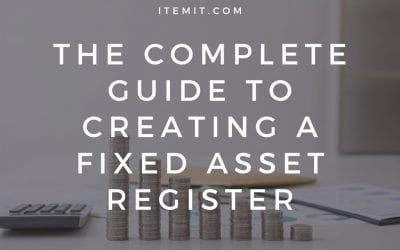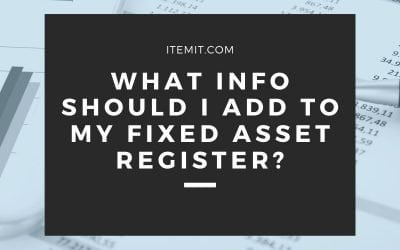Fixed asset tracking operations help your business save time and money. All business need to keep a close eye on their fixed assets. Without a certain level of clarity, you run risks of losing accountability and losing money where it could otherwise be saved.
Most businesses are using spreadsheets for their fixed asset tracking operations. However, the use of spreadsheets creates gaps as they require a lot of manual input. For example, if you’re onsite and notice one of your assets has undergone a change, you’ll most likely need to log this on your spreadsheet later on, as opposed to when you’re physically with the asset.
Fixed asset tracking software allows you to use cloud-based technology to log and monitor any changes assets undergo when you’re onsite, saving you time and money in the process.
What Are Fixed Assets?
Your fixed assets are assets that you don’t sell or use as stock. As such, they’re permanent fixtures in your business. They can either directly or indirectly create revenue in this case, just not through the process of selling the assets.
So, for example, your fixed assets can be furniture, they can be IT assets, such as laptops or phones, and they can even be buildings.
Most fixed assets can be logged as a business expense, too, meaning that you’ll be able to offset your tax repayments by logging these accurately.
What Is Fixed Asset Tracking?
Fixed asset tracking is the process of logging your fixed assets onto a register. Each asset has a unique profile on fixed asset tracking software, where you’ll also be able to add serial information and tag the asset.
Crucially, you must log all of the fixed assets you need to report on onto your fixed asset register. There are a range of helpful features that you can use after this, but the fundamental idea is to have a record of what you own and what you’re using for a greater level of transparency over your asset list.
So, when you’re using fixed asset tracking software, you must have the fundamental information logged, then you’ll be able to use more helpful features tailored towards your requirements.
Once your assets have been logged, you’ll also be able to run exportable reports on them for tax and insurance purposes.
Using Fixed Asset Tags
To improve your fixed asset management, you’ll be able to use fixed asset tags. Fixed asset tags speed up asset discovery, as once your tools and equipment have been tagged, you simply have to scan the tag to find the corresponding asset in your software.
Every time you scan an asset’s tag, too, the last seen location will update as well as the user who scanned the tag and when the scan occurred. This gives you a full view of each asset interaction, allowing you to pinpoint where and when any changes were logged, such as asset damage.
Asset tags also allow you to speed up a few common fixed asset management operations. For example, if you wish to run an audit to verify that all of your assets are in the correct location, you can use these tags to speed this along.
Overall, fixed asset tags lend you more accountability over your fixed asset tracking operations, but they also save you a lot of time and, therefore, money.
Helpful Fixed Asset Management Features
Once you’ve logged and tagged your assets, you’ll be able to use a range of helpful features to track the daily, weekly, or monthly changes your fixed assets will go through.
So, you can also implement maintenance and issues management operations into your tools and equipment tracking by using helpful reminders and issue reporting features.
Then, if you frequently book and check out your assets to your colleagues or other businesses, you will also be able to use your fixed asset tracking system as equipment checkout software.
Every field you add and edit on your asset profiles you can also filter by in your reports. This means that if you need to run reports that specifically show your maintenance data, you can do so.
Depreciation and Asset Lifecycle Features
Other than the maintenance side of things, you can also use depreciation features in your fixed asset management software. Depreciation is where you track the value of a fixed asset over the course of its lifecycle.
So, if you need to track linear depreciation to see either how a specific asset is depreciating in cost or for your entire asset list, you will be able to do so with ease.
Also, as the data you’re adding to your fixed assets is highly customisable, you can also track how assets are behaving throughout their lifecycle.
For example, if an asset has had a regular history of maintenance, you’ll be able to view this and make a clearer decision on when to dispose of this asset.
Using Fixed Asset Tracking For Tax And Insurance
All of this data is usable for tax and insurance purposes, too. When you export a report, you can choose to export it as an excel file or a pdf and choose which data is added to the report.
On the excel file, if you need to add any of your own calculations, you can use your own formulae to fit with your business’ operations.
The pdf report is a clear view of all of your asset list with pictures, too. This is very helpful when it comes to insurance and tax audits, as your reports show your auditors that you own the assets and that they’re being used responsibly.
Also, a clear, regularly updated, and accurate fixed asset register greatly reduces the risk of ghost and zombie assets. These can make your fixed asset register inaccurate and risk fines or overpayment.
Businesses That Can Use Fixed Asset Tracking
All businesses will have fixed assets, and so all businesses can benefit from effective and clear fixed asset tracking software.
However, there are a few specific requirements in each industry, as each industry will have overlapping or non-overlapping asset types that they need to track.
So, offices can use fixed asset tracking software to track their IT assets. Theatres can use asset tracking to track props. It’s possible to implement construction equipment asset tracking, healthcare asset tracking, and you can even create a school fixed asset register.
No matter the assets you’re tracking, you’ll be able to use fixed asset tracking software to save time and money. This is as you’ll be able to add unique, specific asset information against your asset profiles.
The more customisable your asset profiles are, the further you can take your fixed asset tracking.
itemit’s Fixed Asset Tracking Software
itemit’s fixed asset tracking software is being used by businesses worldwide. itemit has customers spanning Africa, New Zealand, Europe, the US, and Asia.
The itemit system is a powerful and customisable software that allows you to log, track and manage any and all of your assets. It uses an integrated app and web portal, meaning if you make any edits with the app on site, these will update on your web view automatically, speeding up your operations and reducing the chance for gaps.
We pride ourselves on our support and will ensure that you’re saving as much money as possible by using the system. To find out more, you can contact the team at team@itemit.com. You can also fill in the form below to start your 14-day free trial.
Fixed Asset Tracking Software
Choose a better way to track your assets
Start your free 14-day trial now
Instant access. No credit card details required.
Related articles
The Complete Guide to Creating a Fixed Asset Register
Our easy to follow guide covers everything you need to know about creating a fixed asset register for your business, as well as how to get the most out of it.
What Information Should I Add to my Fixed Asset Register?
Are you creating a fixed asset register? We’ll share the key information you need to add to your asset register to help manage your assets.
What are the Benefits of a Fixed Asset Register?
The benefits of a fixed asset register include better accountability, responsibility, and higher morale in your company. You can also save time and money with a complete asset register.



